What actually is a walrus? A walrus is a pinniped. What is a pinniped? It is an aquatic carnivorous mammal (such as a seal, sea lion or walrus) with all four limbs modified into flippers.
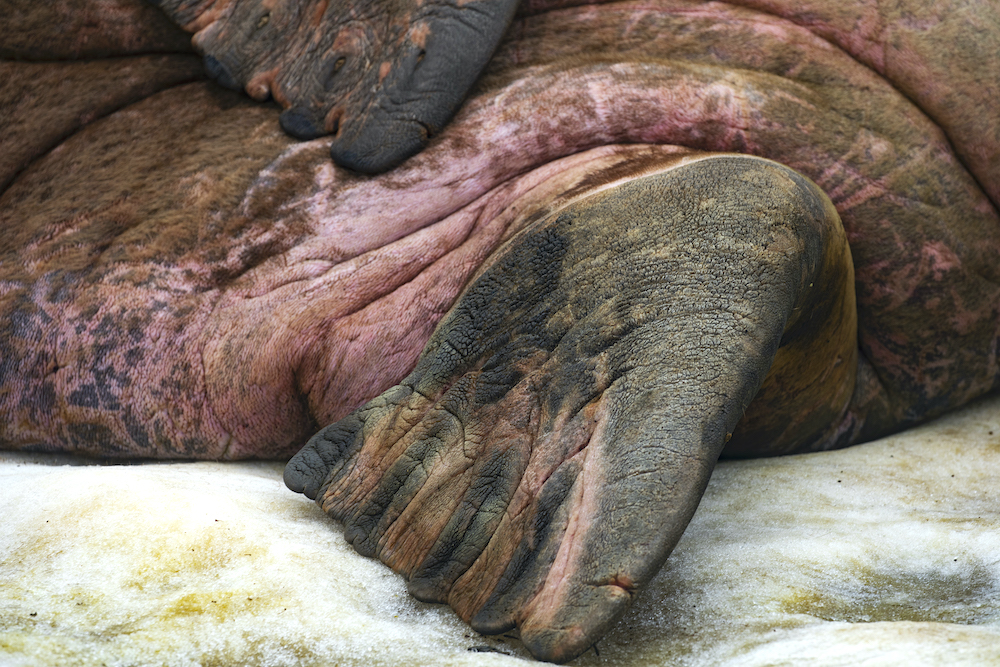
Details of flippers of a walrus laying on an ice floe (Odobenus rosmarus), Svalbard, Norway
The walrus is an Arctic species and thus much harder to study in the wild than the elephant seals and sea lions that flop onto the beaches of Northern California. With wrinkled pink and brown hides, the walrus is a long-tusked marine mammal with grizzly whiskers and an enormous body filled with insulating blubber. They are a keystone species in the Arctic marine ecosystems.
Most scientists recognize two subspecies: the Pacific (Odobenus rosmarus divergent) and Atlantic (Odobenus rosmarus rosmarus)
walruses. These two subspecies are physically and reproductively isolated from one another. One lives in the Pacific Ocean while the other lives in the Atlantic Ocean. The Pacific walrus is larger, has longer tusks and a wider skull. Some scientists recognize a third subspecies of walrus based on being found in the Laptev Sea in the northern Pacific Ocean. This walrus is more similar to the Pacific subspecies but its size is intermediate to the Atlantic and Pacific subspecies.
The name walrus was originated with the Danish word hvalros, meaning “sea horse” or “sea cow”. The Russian word for walrus is morzh, the Inuit name is aivik and the Yu’pik name is aivuk.
Walruses actually “walk” on their teeth. They use their tusks to haul themselves ashore and to move around land. This has led to the nickname “tooth walker” by the Inuits since they appear to be
walking on their teeth. Walruses’ scientific name (Odobenus) translates from Latin into “tooth walking sea horse”.
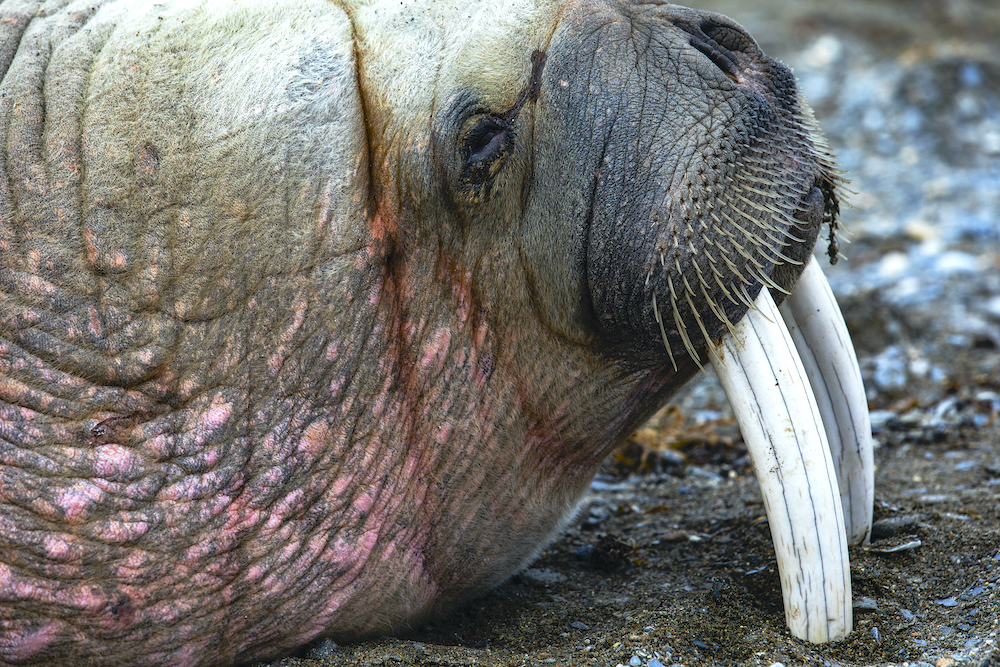
A walrus bull (Odobenus rosmarus divergent) resting on his teeth, close-up, Spitsbergen, Svalbard
Walruses live up to around 40 years in the wild. They are huge. They can weigh up to 1.5 tons (3,000 lbs/1,360 kgs) and can grow up to 11.5 feet in size.
Walruses are intelligent animals. Scientists are gathering evidence that the walrus is the most cognitively and socially sophisticated of all pinnipeds.
The upper canine teeth of the walrus are known as morse or tusks. The tip of the walrus tusk has an enamel coating which is worn away during the animal’s youth. Walruses live under a tusk-based hierarchy. Both sexes grow impressive tusks which can grow to over 3 feet in length. The length of the tusks help to determine social status with the well-endowed walruses commanding the most respect. A broken tusk can actually result in a loss of social status.
On average, they have a 6-inch layer of blubber. Blubber is a thick layer of fat, also called adipose tissue directly beneath the skin of all marine mammals. It covers the entire body – except for their flippers. Blubber stores energy, insulates heat and increases buoyancy. Their skin is covered by a thin layer of short, coarse hairs.
Energy is stored in the oily, thick layer of blubber on a walrus. This energy includes both proteins (mostly collagen) and fats (mostly lipids). The ability of the walrus to use these stored nutrients means that it is not forced to search for food for long periods of time. Nursing mothers, for instance, build up thick stores of blubber before giving birth.
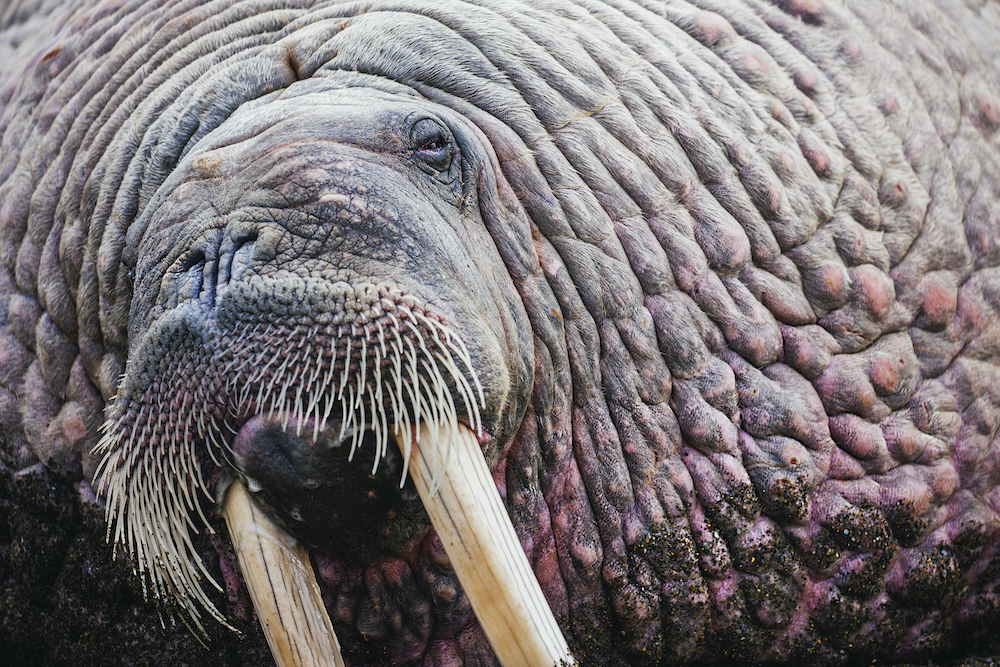
Blubber insulates walruses from the cold. Their blood vessel constrict (or get smaller) in cold water. Constricted blood vessels reduce the amount of blood flow thus reducing the energy required to keep the walrus’ body warm. Last but not least, not only does blubber keep walruses warm, but makes their hide much tougher for predators, like polar bears, to penetrate. They have a protective hide!
What do walruses eat? They have an opportunistic diet, feeding on not only mollusks, clams, shrimp, sea cucumbers and mussels, but also on other pinnipeds. Seal tissue has been observed in fairly significant portions of walrus stomachs in the Pacific However, they prefer clams that they forage for at the sea bottom using their ultra sensitive vibrissae or whiskers.
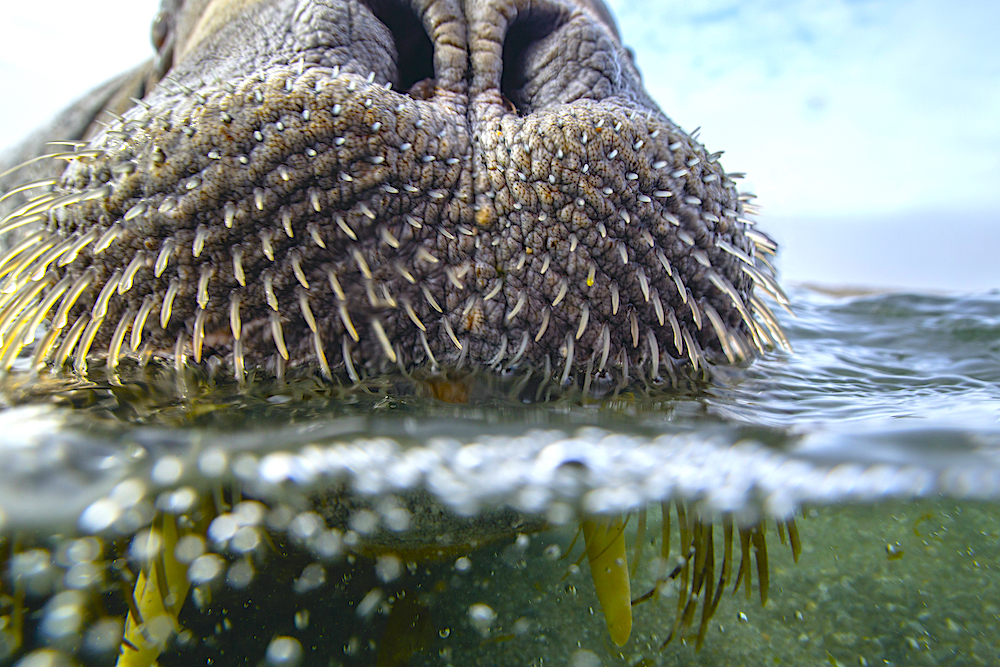
A close-up underwater split image of a walrus (Odobenus rosmarus) whiskers in the Arctic Ocean, Svalbard, Norway
They forage primarily on the sea floor and from ice platforms. They are not significantly deep divers compared to other pinnipeds. Their deepest dive recorded is around 80 meters / 260 feet but they usually feed closer to 30 meters / 100 feet deep.
When they dive, they clear the murky sea bottom with jets of water and active flipper movements while using their whiskers to feel for clams. Then the walrus sucks the meat out of the clam by sealing its powerful lips to the shell and withdrawing its piston-like tongue rapidly into its mouth creating a powerful vacuum. The mouth of the walrus, or its palate, is uniquely designed to enable effective and powerful suction.
Many people want to know, “Are walruses dangerous?” They are considered the gentle giants of the Arctic most of the time, but the other answer is “yes”. The bulls can be very dangerous especially around mating time and the cow can be aggressive when she has a young calf. They are most known to attack people in boats and can cause serious harm with their tusks or by capsizing a boat or kayak. There is one documented case in Spitzbergen (
Svalbard) where walruses capsized a boat killing all aboard.
The plural for walrus is walruses, and the collective nouns for a group of walruses are herd, huddle or pod. Pods of walruses come out of the water to congregate on land. Such areas are referred to as “haul-outs”. Walruses haul-out onto land primarily for birthing, nursing and resting meanwhile they use sea ice as haul-out sites to avoid predators. While on land, it is not uncommon for a walrus to sleep for an uninterrupted 19 sold hours. Walruses can stay away for almost 4 days while at sea and then they need sleep. Sea ice haul-outs are more commonly used for shorter and more frequent haul-outs. Hauling-out is important to walruses because it allows for thermoregulation, therefore wind, temperature and time of day are factors on haul-out locations and duration of time out of the water.
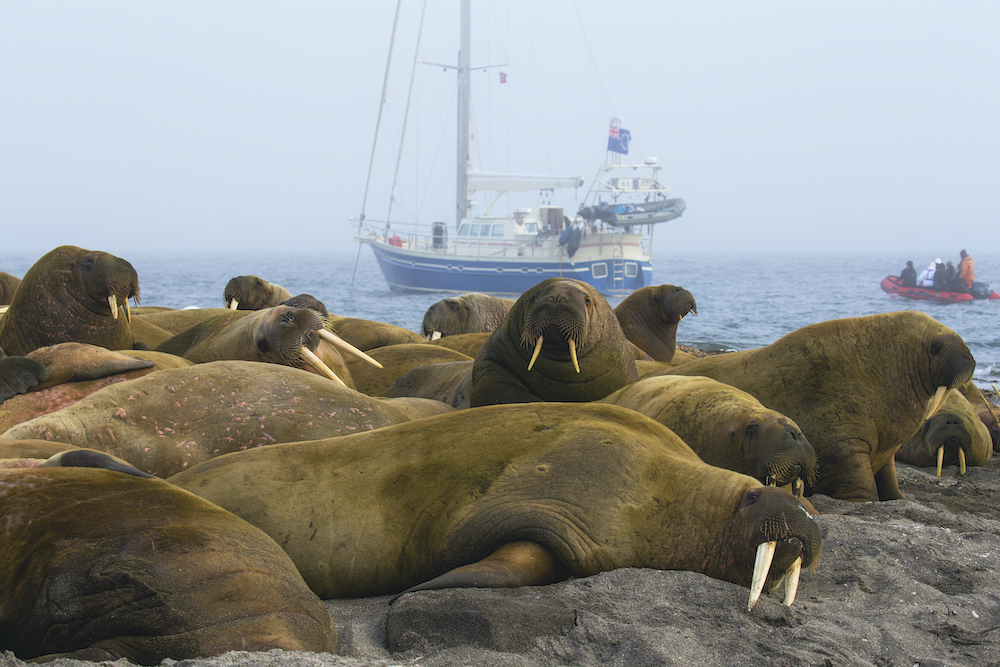
A walrus (Odobenus rosmarus) colony haul-out on the shore, Svalbard, Norway
But the desperate need for haul-outs is dangerous for walruses. Walruses spend most of their time on sea ice. They migrate with moving ice floes and need ice in order to rest between dives for food. But climate change is dramatically shrinking available sea ice for walruses. As a result, thousands of walruses are swimming much farther distances to seek refuge on shore when no ice is available.
With declining ice, commutes to shore can be more than 100 miles. Often, young calves do not survive the full journey.
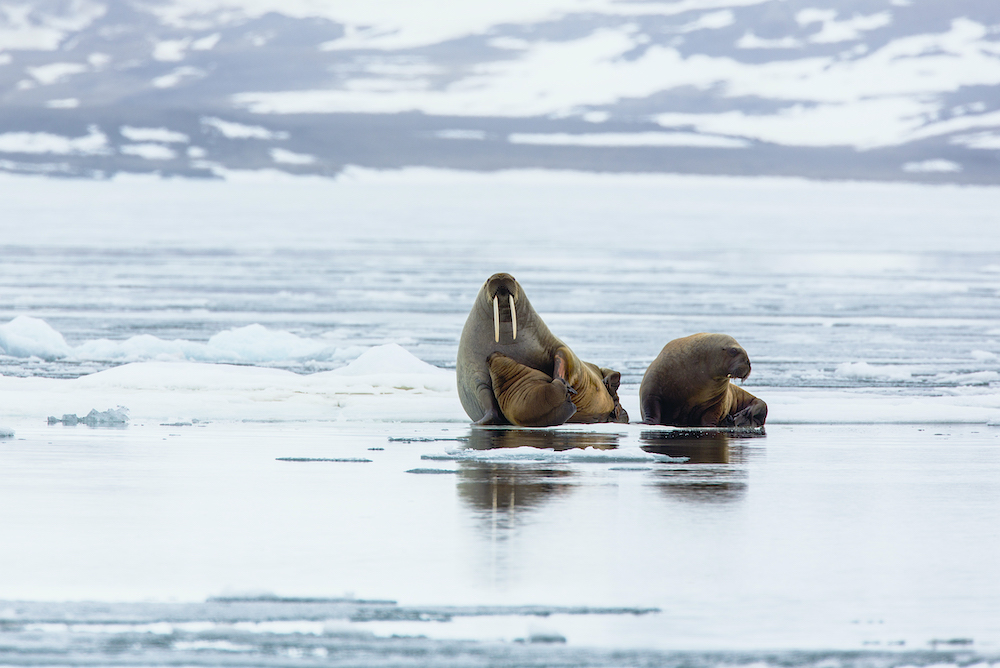
A female walrus nursing her youngest pup (Odobenus rosmarus) while laying on a piece of sea ice in the Arctic, Svalbard, Norway
If they do make it to land, walruses are already fatigued by their travel, and in these locations, nearby food sources may be quickly exhausted. In addition, as walrus are easily spooked—by humans, polar bears, or even small animals—they can trample one another in a stampede to the sea. Tragically, many walruses, particularly young calves, die in these stampedes.
Recent years have seen the number of walruses congregating in single haul-outs to more than 35,000. The increase in size and frequency is due to disappearing sea ice brought on by rising global temperatures.
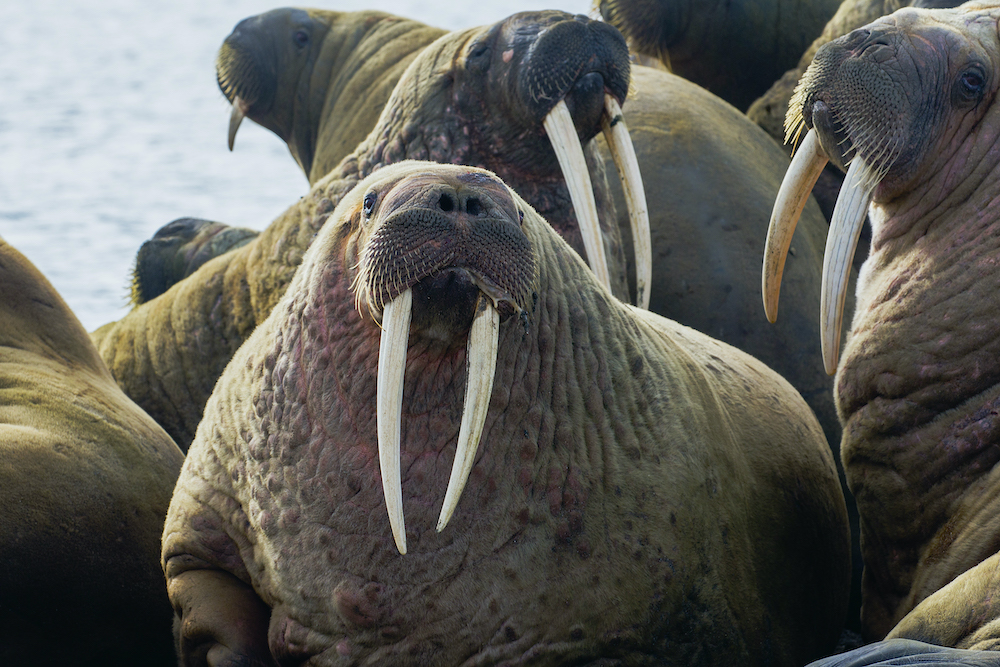
Several walrus bulls (Odobenus rosmarus) displaying their ivory tusks in a colony haul out , Svalbard, Norway
The greatest natural threats to the walrus are orcas by sea and
polar bears by land. These are the only predators of walruses. An aggressive walrus can be dangerous for a polar bear in the water. There have been isolated observations of walruses attacking
polar bears in the water, though this is unusual behavior. Walruses generally react to polar bears as predators – they fear and avoid them. However, when protecting their young, a female walrus when agitated is a tough fighter and can cause serious injury and even death to a polar bear.
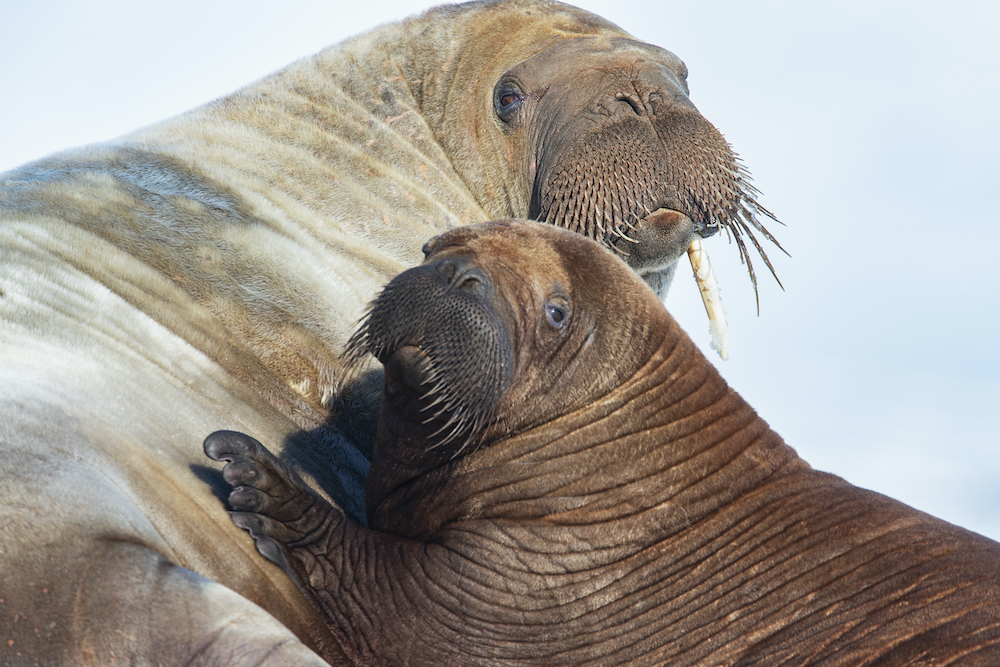
A walrus, or a “tooth-walking sea horse, and her young (Odobenus rosmarus) laying on an ice floe together in the Arctic, Svalbard, Norway
Hunting is the greatest man-made threat to walruses. Native peoples in Alaska, Russia and
Greenland are allowed to “harvest” walruses for subsistence and handicraft purposes. Because the “harvest” must be accomplished in a non-wasteful manner, taking walrus only for their ivory is not allowed.
Walrus hunting is prohibited in
Svalbard. Svalbard is one of the best places in the world to see walruses. The
Svalbard walruses have no fear of humans due to the fact that hunting is strictly prohibited.
Walrus trophy hunting is allowed in Canada and is conducted out of Nunavut communities in motorized boats. They transport the hunter to areas where walruses are spotted on ice flows or rocky islands. They boast a 100% success rate for hunting. One hunting outfitter advertises their trips with the following description (the cost is $12,500 per walrus):
“Shooting ranges are close in, usually under 35 meters (approximately 40 yards). A brain shot, or even better, a neck shot for instant kill is recommended. The outfitter recommends rifle calibers nothing smaller than a .300 Winchester magnum for walrus. Even better, are calibers such as .338 and .375 or European calibers of 8X68 mm or 9.3 mm. Ammunition, by law, must have expanding bullets such as Barnes X, Bear Claw, Nosler Partition or equivalent. Rifles should be equipped with low powered scopes such as a 1X4 variable magnification scope and sighted in for 25 yards. Walruses are the gentle giants of the Arctic. They are among the largest pinnipeds — fin-footed, semiaquatic marine mammals. However, while they have an intimidating size, and are carnivores, these animals are not aggressive.”
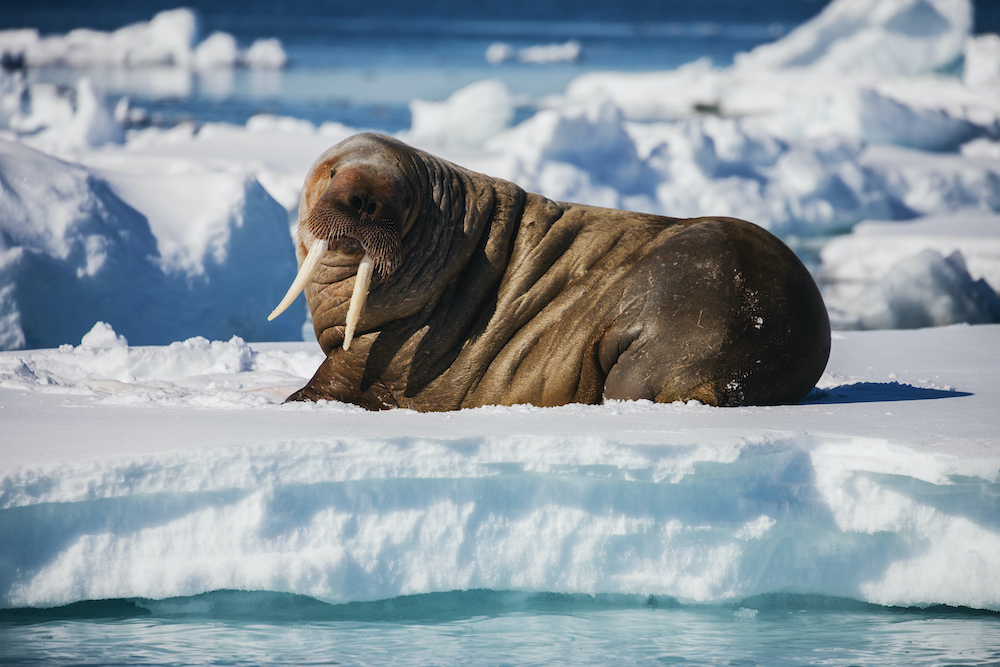
Ancient cultures of the Arctic discovered the benefits of blubber in their diets. Muktuk, a traditional food consumed by Inuit and Eskimo people was thick slices of whale blubber from whales. It was the chief source of vitamin C for these Arctic people. The Inuit ate (and still do eat) raw walrus meat and blubber. They also boil it or ferment it. Stomach contents of Arctic walrus was considered a delicacy by the Iglulik peoples of Canada.
You can fine these mustached and long-tusked
walrus lying on the ice in the Arctic with hundreds of companions. These over-sized animals are extremely sociable, prone to bellowing and snorting at one another. Currently, the IUCN has given the walrus a red listed status of ‘vulnerable’. They are not considered to be endangered yet, and let us hope that it stays this way. They are an icon of the Arctic region.
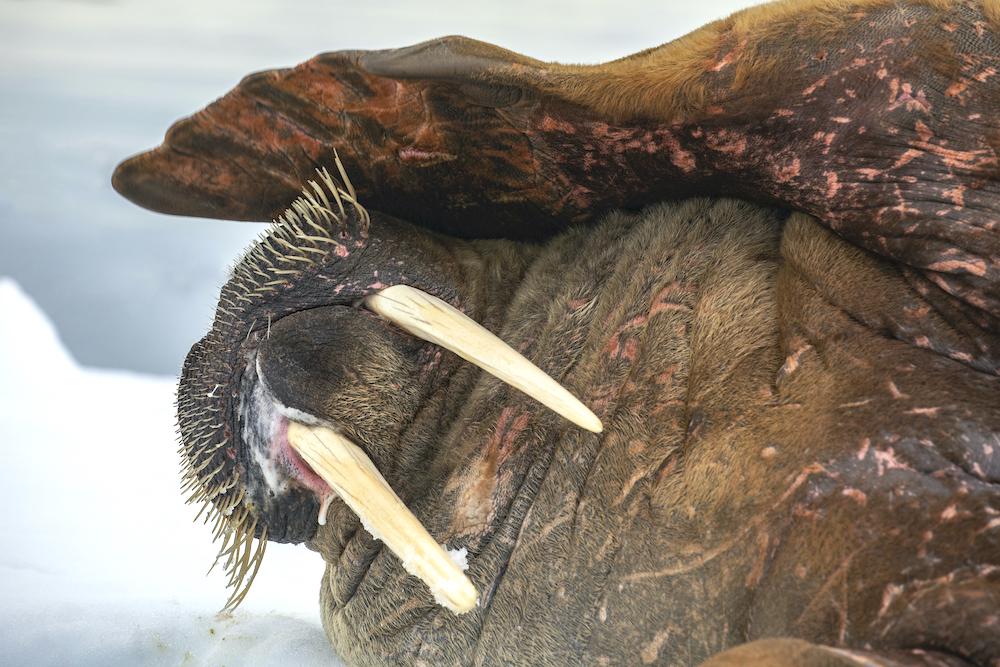
A walrus (Odobenus rosmarus), or a “tooth-walking sea horse, laying on an ice floe in the Arctic, Svalbard, Norway
All images copyright ©JamiTarrisPhotography
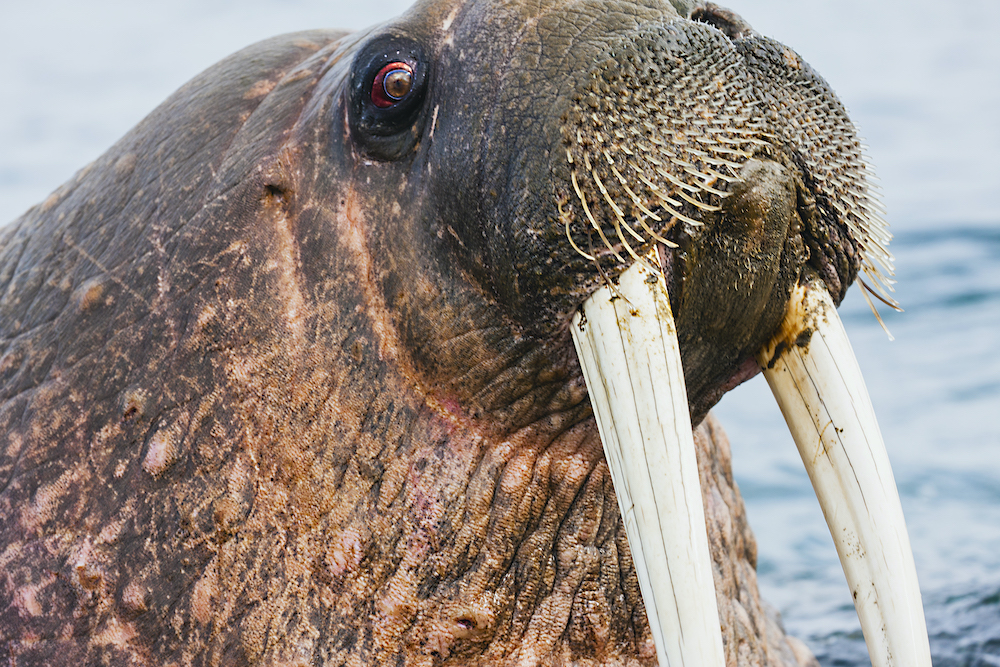












Leave a Reply
Want to join the discussion?Feel free to contribute!